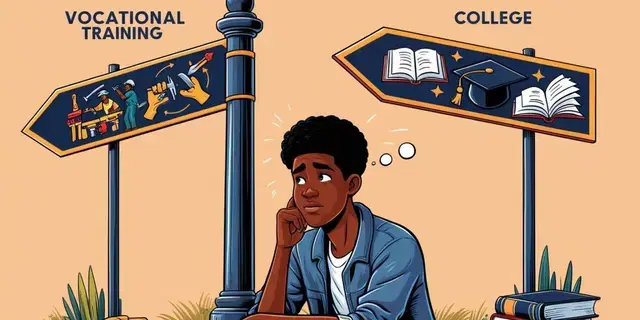

Share on:
Copy Link

By ADMI Editorial Team
2 min read
Making Big Decisions: How to Choose Between Vocational Training and College
Step 1: Understand What Each Path Offers
Vocational Training
Focuses on hands-on skills for specific jobs like plumbing, graphic design, fashion, and IT.
Courses are often shorter (6 months to 2 years).
Emphasizes practical work over theory.
Examples: Electricians, mechanics, chefs, and beauty professionals.
College/college
Provides broader academic education in fields like medicine, law, business, and engineering.
Takes longer (3 to 5 years).
Focuses more on theory with some practical elements.
Examples: Teachers, engineers, doctors, and accountants.
Step 2: Consider Your Career Goals
Think about the kind of work you see yourself doing:
If you enjoy working with your hands and want to enter the job market sooner, vocational training may be the right choice.
If you’re interested in a professional field that requires certification or licenses (like medicine or law), college is necessary.
Tip: Research careers you’re curious about and check the qualifications required on platforms like LinkedIn or career-focused sites like Brighter Monday.
Step 3: Compare Learning Styles
Consider how you learn best:
Vocational Training: Ideal for hands-on learners who prefer working on projects, practical workshops, and real-world scenarios.
College: Better suited for those who enjoy academic studies, research, and exploring multiple subjects before specializing.
If you’re unsure, try short courses on platforms like Google Digital Skills for Africa to see which learning style fits you.
Step 4: Evaluate Costs and Timelines
Vocational Training: Shorter courses and lower costs compared to college.
College: Higher tuition fees but may lead to careers with long-term earning potential in specialized fields.
Remember, both paths can lead to financial success. Many vocational careers, like electricians and IT specialists, can be highly rewarding.
Step 5: Explore Hybrid Options
You don’t always have to choose just one path. Some careers benefit from both practical skills and formal education. For example:
Graphic Design: You can take a short vocational course, and then pursue a design-related degree.
Entrepreneurship: Vocational skills combined with a business course can be a powerful combination.
Conclusion
Whether you choose vocational training or college, both paths can lead to fulfilling careers. The key is to focus on what suits your strengths, goals, and the kind of future you want to create. Take your time, explore your options, and make the choice that feels right for you.
Watch: Technical and Vocational Education and Training (TVET): By Kate Kiguru, the CEO of Ukall Apps
Related Articles
Crafting a Fulfilling Career in Music: Strategies, Challenges, and Prospects
Are you passionate about music? Do you dream of making a career out of your love for melodies, rhythms, and lyrics? If so, you’re not alone. The music industry is a vast and dynamic field with numerous opportunities waiting to be explored. In this article, we’ll dive deep into the world of music careers, shedding light on how you can make a mark in this ever-evolving industry.
Navigating the Digital Canvas: Exploring Diverse Career Paths in Graphic Design
Graphic design is a dynamic and ever-evolving field, offering a plethora of exciting career paths for creative minds. From crafting immersive user experiences to defining brand identities, the world of graphic design spans various disciplines, each with its unique set of challenges and opportunities. In this article, we’ll embark on a journey through the digital canvas, exploring diverse career paths within graphic design and shedding light on the distinctive skill sets required for success in each domain.
Introducing Aquila Creative Scholars: Your Gateway to a Thriving Creative Career
The Africa Digital Media Foundation, in partnership with a generous anonymous donor, is thrilled to announce the launch of the Aquila Creative Scholars program. Aquila, which means eagle in Spanish, expressed the program’s aspiration to help the next generation of creative professionals soar by offering partial scholarships to talented individuals pursuing training in five dynamic fields.
